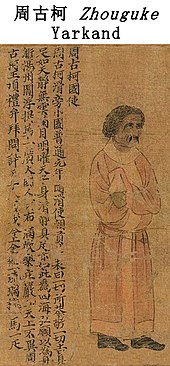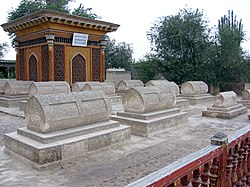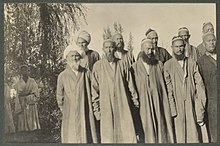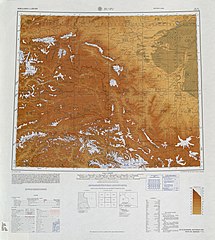Condado de Yarkant

Content
História
Dinastia Han
O território de Yārkand é mencionado pela primeira vez no livro de Han (século I aC) como "shaju" (chinês velho, aproximadamente, *s³a (j) -ka), que provavelmente está relacionado ao nome das tribos iranianas Saka. As descrições no Hou Hanshu ('História de Han posterior') contêm informações sobre a complexa situação política que a China enfrentou na tentativa de abrir as "rotas de seda" a oeste no século I.C. De acordo com o "capítulo sobre as regiões ocidentais" no Hou Hanshu:
"Going west from the kingdom of Suoju (Yarkand), and passing through the countries of Puli (Tashkurghan) and Wulei (centred on Sarhad in the Wakhan), you arrive among the Da Yuezhi (Kushans). To the east, it is 10,950 li (4,553 km) from Luoyang.The Chanyu (Khan) of the Xiongnu took advantage of the chaos caused by Wang Mang (9-24 CE) and invaded the Western Regions. Only Yan, the king of Suoju, who was more powerful than the others, did not consent to being annexed. Previously, during the time of Emperor Yuan (48-33 BCE), he was a hostage prince and grew up in the capital. He admired and loved the Middle Kingdom and extended the rules of Chinese administration to his own country. He ordered all his sons to respectfully serve the Han dynasty generation by generation, and to never turn their backs on it. Yan died in the fifth Tianfeng year (18 CE). He was awarded the posthumous title of 'Faithful and Martial King'. His son, Kang, succeeded him on the throne.At the beginning of Emperor Guangwu's reign (25-57 CE), Kang led the neighboring kingdoms to resist the Xiongnu. He escorted, and protected, more than a thousand people including the officers, the soldiers, the wife and children of the former Protector General. He sent a letter to Hexi (Chinese territory west of the Yellow River) to inquire about the activities of the Middle Kingdom, and personally expressed his attachment to, and admiration for, the Han dynasty.In the fifth Jianwu year (29 CE) the General-in-Chief of Hexi, Dou Rong, following Imperial instructions, bestowed on Kang the titles of: “King of Chinese Suoju, Performer of Heroic Deeds Who Cherishes Virtue [and] Commandant-in-Chief of the Western Regions.” The fifty-five kingdoms were all made dependencies after that.In the ninth year (33 CE) Kang died. He was awarded the posthumous title of “Greatly Accomplished King.” His younger brother, Xian, succeeded him on the throne. Xian attacked and conquered the kingdoms of Jumi (Keriya) and Xiye (Karghalik). He killed both their kings, and installed two sons of his elder brother, Kang, as the kings of Jumi and Xiye.In the fourteenth year (38 CE), together with An, the king of Shanshan (the Lop Nor region), he sent envoys to the Imperial Palace to offer tribute. Following this, the Western Regions were (again) in communication with China. All the kingdoms to the east of the Congling (Pamirs) were dependent on Xian.In the seventeenth year (41 CE), Xian again sent an envoy to present offerings [to the Emperor], and to ask that a Protector General be appointed. The Son of Heaven questioned the Excellency of Works, Dou Rong, about this. He was of the opinion that Xian, and his sons and brothers who had pledged to serve the Han were truly sincere. Therefore, [he suggested that] it would be appropriate to give him higher rank to maintain order and security.
"Pei Zun, administrador de Dunhuang, escreveu dizendo que os estrangeiros não deveriam empregar uma autoridade tão grande e que esses decretos causariam a desespero dos reinos. Um decreto imperial ordenou que o selo e as fitas do" Protetor Geral "fossem recuperadas , e substituído pelo selo e fita de "Great Han General". O enviado de Xian se recusou a fazer a troca e (PEI) Zun os levou pela força.
Consequently, Xian became resentful. Furthermore, he falsely named himself “Great Protector General,” and sent letters to all the kingdoms. They all submitted to him, and bestowed the title of Chanyu on him. Xian gradually became arrogant making heavy demands for duties and taxes. Several times he attacked Qiuci (Kucha) and the other kingdoms. All the kingdoms were anxious and fearful.In the winter of the twenty-first year (45 CE), eighteen kings, including the king of Nearer Jushi (Turpan), Shanshan, Yanqi (Karashahr), and others, sent their sons to enter the service of the Emperor and offered treasure. As a result, they were granted audience when they circulated weeping, prostrating with their foreheads to the ground, in the hope of obtaining a Protector General. The Son of Heaven, considering that the Middle Kingdom was just beginning to return to peace and that the northern frontier regions were still unsettled, returned all the hostage princes with generous gifts.At the same time, Xian, infatuated with his military power, wanted to annex the Western Regions, and greatly increased his attacks. The kingdoms, informed that no Protector General would be sent, and that the hostage princes were all returning, were very worried and frightened. Therefore, they sent a letter to the Administrator of Dunhuang to ask him to detain their hostage sons with him, so that they could point this out to the [king of] Suoju (Yarkand), and tell him that their young hostage sons were detained because a Protector General was to be sent. Then he [the king of Yarkand] would stop his hostilities. Pei Zun sent an official report informing the Emperor [of this proposal], which he approved.In the twenty-second year (46 CE Xian, aware that no Protector General was coming, sent a letter to An, king of Shanshan, ordering him to cut the route to the Han. An did not accept [this order], and killed the envoy. Xian was furious and sent soldiers to attack Shanshan. An gave battle but was defeated and fled into the mountains. Xian killed or captured more than a thousand men, and then withdrew.


Em 90 CE, os Yuezhi ou Kushans invadiram a região com um exército de 70.000 homens, sob seu vice -rei, Xian, mas foram forçados a se retirar sem uma batalha depois que Ban Chao instigou uma política de "terra queimada".
Após o período de Yuanchu (114-120 dC), quando o Yuezhi ou Kushans colocou um príncipe refém no trono de Kashgar:
"... Suoju [Yarkand] followed by resisting Yutian [Khotan], and put themselves under Shule [Kashgar]. Thus Shule [Kashgar], became powerful and a rival to Qiuci [Kucha] and Yutian [Khotan].""In the second Yongjian year [127 CE] of the reign of Emperor Shun, [Ban] Yong once again attacked and subdued Yanqi [Karashahr]; and then Qiuci [Kucha], Shule [Kashgar], Yutian [Khotan], Suoju [Yarkand], and other kingdoms, seventeen altogether, came to submit. Following this, the Wusun [Ili River Basin and Issyk Kul], and the countries of the Congling [Pamir Mountains], put an end to their disruptions to communications with the west."Em 130 CE, Yarkand, juntamente com Ferghana e Kashgar, enviaram homenagem e ofertas ao imperador chinês.
História posterior



Há muito pouca informação sobre a história de Yarkant por muitos séculos, além de algumas breves referências nas histórias da dinastia Tang (618-907) e parece ter sido de menos nota do que o oásis de Kharghalik (ver Yecheng e Yecheng County) para seu sul.
Foi possivelmente capturado pelos muçulmanos logo depois que eles subjugaram Kashgar no início do século 10/11. [Citação necessária]
A área tornou -se a base principal da região de Chagatai Khan (morreu em 1241), que herdou Kashgaria (e também grande parte da terra entre os rios Oxus (Amu Darya) e Jaxartes (Syr Darya)) depois que seu pai, Genghis Khan, morreu em 1227.
Marco Polo descreveu Yarkant em 1273, mas disse apenas que essa "província" (do sobrinho de Kublai Khan, Kaidu, m. 1301) foi, "Jornada de cinco dias em extensão. Os habitantes seguem a lei de Mahomet, e também existem alguns Cristãos Nestorianos. Eles estão sujeitos ao sobrinho do Grande Khan. É amplamente abastecido com os meios de vida, especialmente o algodão ".

No final do século XVI, Yarkant foi incorporado ao Khanate de Kashgar e se tornou sua capital. O jesuíta Benedict Göez, que procurou uma rota do Império Mughal para Cathay (que, segundo seus superiores, pode ou não ter sido o mesmo lugar que a China), chegou a Yarkant com uma caravana de Cabul no final de 1603. Ele permaneceu Lá por cerca de um ano, fazendo uma curta viagem a Khotan durante esse período. Ele relatou:
"Hiarchan [Yarkant], the capital of the kingdom of Cascar, is a mart of much note, both for the great concourse of merchants, and for the variety of wares. At this capital the caravan of Kabul merchants reaches its terminus; and a new one is formed for the journey to Cathay. The command of this caravan is sold by the king, who invests the chiefs with a kind of royal authority over the merchants for the whole journey. A twelvemonth passed away however before the new company was formed, for the way is long and perilous, and the caravan is not formed every year, but only when a large number arrange to join it, and when it is known that they will be allowed to enter Cathay."Durante sua jornada, Göez também observou a presença de grandes pedreiras de mármore na área, levando -o a escrever isso entre os viajantes nativos de Yarkant a Catay:
"no article of traffic is more valuable or more generally adopted as an investment for this journey than lumps of a certain transparent kind of marble called by the Chinese "jusce" (jade). They carry these to the Emperor of Cathay, attracted by the high prices which he deems it obligatory on his dignity to give ; and such pieces as the Emperor does not fancy they are free to dispose of to private individuals."Yarkent Khanate
Yarkent serviu como capital do Yarkent Khanate, também conhecido como Yarkent State, desde o estabelecimento de Yarkent Khanate até sua queda (1514-1713).
O Khanate era predominantemente Uyghur/Turki; Algumas de suas cidades mais populosas foram Hotan, Yarkent, Kashgar, Yangihissar, Aksu, Uchturpan, Kucha, Karashar, Turpan e Kumul. Ele desfrutou de domínio contínuo na região por cerca de 200 anos até ser conquistado pelo Dzungar Khan, Tsewang Rabtan em 1705.
Na primeira metade do século 14, o Khanate de Chagatai havia desmoronado; Na parte ocidental do Chagatai Khanate desabado, o império de Timur emergiu em 1370 e se tornou o poder dominante na região até sua conquista em 1508 pelos Shaybanids. Sua parte oriental tornou -se o Moghulistão, criado por Tughluk Timur Khan em 1347, com a capital centrada em Almalik, ao redor do vale do rio Ili. Compreia todas as terras estabelecidas do leste da Kashgaria, bem como regiões de Turpan e Kumul, que eram conhecidas na época como o Uyghurstan, de acordo com Balkh e fontes indianas dos séculos XVI e XVII. A reinante dinastia do Yarkent Khanate se originou desse estado, que existia por mais de um século.
Em 1509, os dughlats, governantes vassalos da bacia de Tarim, se rebelaram contra o Moghulistan Khanate e se separaram. Cinco anos depois, Sultan disse que Khan, um irmão do Khan do Moghulistão, em Turfan, conquistou os Duphlats, mas estabeleceu seu próprio khanato Yarkent.
Isso acabou com o domínio nas cidades da Kashgária, dos Emirs Duphlat, que os controlava desde 1220, quando a maior parte da Kashgaria foi concedida ao Duphlat pelo próprio Chagatai Khan. A conquista dos dughlats permitiu que o estado Yarkent se tornasse o principal poder da região.
Dinastia Qing

A dinastia Qing ganhou o controle da região em meados do século XVIII.

No século XIX, devido ao seu comércio ativo com Ladakh e um afluxo de comerciantes estrangeiros, tornou -se "o maior e mais populoso de todos os estados de Káshghar". (Kashgar). Yakub Beg (1820-1877) conquistou Khotan, Aksu, Kashgar e cidades vizinhas com a ajuda dos russos na década de 1860. Ele fez de Yarkant a capital do recém -fundado estado turco de Yettishar, onde recebeu embaixadas da Inglaterra em 1870 e 1873. A dinastia Qing derrotou Yakub em Turpan em 1877, após o que cometeu suicídio. Assim terminou o reino de Yettishar, e a região retornou ao controle chinês de Qing.
Comerciantes e soldados chineses, estrangeiros como russos, muçulmanos estrangeiros e outros comerciantes turcos envolvidos em casamentos temporários com mulheres Turki (Uyghur), uma vez que muitos estrangeiros viviam em Yarkand, o casamento temporário floresceu lá mais do que em áreas com menos estrangeiros como áreas para o leste de Kucha. O conde de Dunmore escreveu em 1894:
Quase todos os chineses em Yarkand, soldados ou civis, levam a si mesmo uma esposa temporária, dispensando inteiramente os serviços do clero, como sendo supérfluo, e a maioria dos altos funcionários também dá lugar à mesma fraqueza amável, suas amantes estão em quase Todos os casos nativos de Khotan, que a cidade desfruta da distinção invejável de fornecer todas as grandes cidades do Turquestão a cortesãs.
Quando um chinês é chamado de volta para sua própria casa na China apropriada, ou um soldado chinês serviu seu tempo no Turquestão e precisa retornar à sua cidade natal, Pekin ou Shanghai, ele deixa sua esposa temporária para trás para mudar para si mesma, ou Ele a vende a um amigo. Se ele tem uma família, ele leva os meninos com ele ~ - se ele puder pagar - projetando isso, os filhos são deixados sozinhos e desprotegidos para travar a Batalha da Vida, enquanto no caso das filhas, ele as vende para um de seus ex -companheiros de uma quantia insignificante.
Os nativos, embora todos os maometanos, tenham uma forte predileção para os chineses, e parecem gostar de suas maneiras e costumes, e nunca parecem se ressentir desse comportamento à sua mulher, suas próprias maneiras, costumes e moral (?) Sendo do próprio Descrição mais frouxa.
Século XX



A Batalha de Yarkand ocorreu no condado de Yarkant, em abril de 1934. O exército muçulmano chinês de Ma Zhancang derrotou o Exército Turkic Uighur e Kirghiz, e os voluntários afegãos enviados pelo rei Mohammed Zahir Shah e exterminaram todos. O Emir Abdullah Bughra foi morto e decapitado, sua cabeça foi enviada para a mesquita de Idgah.
Quase todos os edifícios antigos da cidade antiga foram destruídos durante a Revolução Cultural (1966-1968), com apenas a mesquita central, o portão principal do antigo palácio e o cemitério real sobrevivendo.
Após os tumultos em Yarkant no verão de 2014, muitas dezenas de pessoas, incluindo Hans e Uyghurs, morreram, com estimativas que variam do total da mídia estatal de 96 a mais de 1.000, de acordo com alguns moradores e Rebiya Kadeer, presidente do Congresso Mundial Uyghur, com sede na Alemanha, (WUC). Em agosto de 2015, foi relatado pela mídia chinesa que a quantidade de terras agrícolas per capita aumentou de 2,6 MU por pessoa para 3,5 MU depois de esclarecer terras mais aráveis.
Geografia
Yarkant está estrategicamente localizado a meio caminho entre Kashgar e Khotan, no cruzamento de uma estrada de filial para o norte, para Aksu. Também foi o terminal para caravanas vindas da Caxemira via Ladakh e depois sobre o passe de Karakoram para o oásis de Niya na bacia de Tarim. A estrada nacional 219 da Xinjiang-Tibet Highway China, construída em 1956, começa em Yecheng/Yarkant e segue para o sul e oeste, ao outro lado do queixo Aksai e ao Tibete Central.
De Yarkant, outra rota importante seguiu para o sudoeste pela cidade de Tashkurgan até o corredor Wakhan, de onde os viajantes poderiam atravessar o relativamente fácil Baroghil Pass e Badakshan.
Clima
Como em grande parte do sul de Xinjiang, Yarkant possui uma zona temperada, Continental (Köppen BWK), com um total médio de apenas 61 mm (2,40 pol.) De precipitação por ano. Como a primavera e o outono são curtos, o inverno e o verão são as principais estações. A temperatura média diária mensal varia de -5,2 ° C (22,6 ° F) em janeiro a 25,3 ° C (77,5 ° F) em julho; A média anual é de 12,01 ° C (53,6 ° F). A variação diurna da temperatura não é particularmente grande para um deserto, com média de 13,3 ° C (23,9 ° F) anualmente. Com o porcentagem mensal possível de sol, variando de 56% em março a 75% em outubro, o assento do condado recebe 2.860 horas de sol brilhante anualmente.
divisões administrativas
Distrito controlado pelo condado (县 辖区)
Tuomuwusitang District (托木吾斯塘区) | Yishikuli District (伊什库力区) | Wudalike District (乌达力克区) | Huoshilapu District (霍什拉甫区) | Awati District (阿瓦提区) | Ailixihu District (艾力西湖区) | Baishikante District (白什坎特区)Subdistritos
Yarkant Subdistrict (Ye'erqiang; 叶尔羌街道), Chengzhong Subdistrict (城中街道), Chengdong Subdistrict (城东街道), Chengxi Subdistrict (城西街道), Chengbei Subdistrict (城北街道)Cidades (بازىرى / 镇)
Yarkant Town (Shache; يەكەن بازىرى / 莎车镇), Charak (Qiareke; چارەك بازىرى / 恰热克镇), Awat (Awati; ئاۋات بازىرى / 阿瓦提镇), Elishku (Ailixihu, Elishqu; ئېلىشقۇ بازىرى / 艾力西湖镇), Hangdi (Huangdi; خاڭدى بازىرى / 荒地镇), Beshkent (Baishikante; بەشكەنت بازىرى / 白什坎特镇), Egerchi (Yigai'erqi; ئېگەرچى بازىرى / 依盖尔其镇), Tomosteng (Tuomu Wusitang, Tuomuwusitang; 托木吾斯塘镇, formerly Tomosteng Township تومئۆستەڭ يېزىسى / 托木吾斯塘乡), Misha (Mixia; مىشا بازىرى / 米夏镇, formerly Misha Township 米夏乡), Odanlik (Wudalike; 乌达力克镇, formerly Odanlik Township ئودانلىق يېزىسى / 乌达力克乡), Alamet (Alamaiti; 阿拉买提镇, formerly a Alamet Township ئالامەت يېزىسى / 阿拉买提乡)Municípios ( / 乡)
Gulbagh Township (Gulebage; گۈلباغ بازىرى / 古勒巴格乡), Yengiostang Township (Yingwusitang; يېڭىئۆستەڭ يېزىسى / 英吾斯塘乡), Aral Township (Arele; ئارال يېزىسى / 阿热勒乡), Charbagh Township (Qia'erbage; چارباغ يېزىسى / 恰尔巴格乡), Ishkul Township (Yishikuli; ئىشقۇل يېزىسى / 伊什库力乡), Tagharchi Township (Taga'erqi; تاغارچى يېزىسى / 塔尕尔其乡), Pekichi Township (Paikeqi; پەكىچى يېزىسى / 拍克其乡), Arslanbagh Township (A'ersilanbage; ئارسلانباغ يېزىسى / 阿尔斯兰巴格乡), Yaqaerik Township (Yaka'airike; ياقائېرىق يېزىسى / 亚喀艾日克乡), Kachung Township (Kaqun; كاچۇڭ يېزىسى / 喀群乡), Koshirap Township (Huoshilafu; قوشىراپ يېزىسى / 霍什拉甫乡/藿什拉甫乡), Damsi Township (Damusi; دامسى يېزىسى / 达木斯乡), Azadbagh Township (Azhatibage; ئازادباغ يېزىسى / 阿扎特巴格乡), Kosh’erik Township (Kuoshi'airike; قوشئېرىق يېزىسى / 阔什艾日克乡), Dongbagh Township (Dunbage; دۆڭباغ يېزىسى / 墩巴格乡), Baghawat Township (Bage'awati; باغئاۋات يېزىسى / 巴格阿瓦提乡), Karasu Township (Kalasu; قاراسۇ يېزىسى / 喀拉苏乡)Municípios étnicos (民族乡)
孜热甫夏提塔吉克族乡 Zerepshat Tajik townshipOutro (其他)
莎车农场 | 莎车县良种场 | 莎车县国营农场 | 喀什监狱莎车县 各 县 辖区 管辖 乡镇 Distrito de Tuomuwusitang (托木吾斯塘区)
古勒巴格乡 | 托木吾斯塘乡 | 英吾斯塘乡 | 阿热勒乡 | 恰尔巴格乡Distrito de Tuomuwusitang (托木吾斯塘区)
伊什库力乡 | 米夏乡 | 塔尕尔其乡 | 拍克其乡Distrito Wudalike (乌达力克区)
热克镇 | 乌达力克乡 | 阿尔斯兰巴格乡 | 亚喀艾日克乡 | 孜热甫夏提塔吉克族乡Distrito de Huoshilafu (霍什拉甫区)
喀群乡 | 霍什拉甫乡 | 达木斯乡Distrito de Awat (阿瓦提区)
Awat Town (阿瓦提镇) | Alamaiti Township (阿拉买提乡) | Azatibage Township (阿扎提巴格乡)Distrito de Aili West Lake (艾力 西湖区)
Ailixihu Town (艾力西湖镇) | Huangdi Town (荒地镇) | Kuoshiairike Township (阔什艾日克乡) | Dunbage Township (墩巴格乡)Distrito Especial de Baishikan (白什坎特区)
白什坎特镇 | 依盖尔其镇 | 巴格阿瓦提乡 | 喀拉苏乡Economia
O Condado de Yarkant é um importante produtor de trigo, milho, arroz, colza e algodão no sul de Xinjiang. A área também produz uvas, tapetes e produtos de couro. As indústrias incluem eletrônicos, carvão, seda, reparo do trator e processamento de algodão e óleo de cozinha.
Em 1885 [Atualização], havia cerca de 154.600 acres (1.021.500 mu) de terra cultivada em Yarkant.
Dados demográficos
Historical populationYearPop.±% p.a.2000620,329— 2010762,385+2.08%Em 2015, 818.379 dos 851.374 residentes do condado eram Uyghur, 25.404 eram chineses Han e 7.591 eram de outros grupos étnicos.
Em 1999, 95,71% da população do condado de Yarkant (Shache) era Uyghur e 3,47% da população era chinesa.
Transporte
Yarkant é servido pela China National Highway 315, pelo aeroporto ferroviário de Kashgar-Hotan e shache.
Mapas históricos
Mapas históricos em inglês, incluindo Yarkant:

Mapa, incluindo Yarkant (rotulado como shache (sha-ch'e) (DMA, 1980)

Mapa, incluindo Yarkant (rotulado como So-Ch'e (Yarkand)) (AMS, 1966)

Do gráfico de navegação operacional; Mapa, incluindo Yarkant (rotulado como shache (So-ch'e)) (DMA, 1980)

Mapa, incluindo Yarkant (rotulado como shache (So-Ch'e)) (DMA, 1984)






